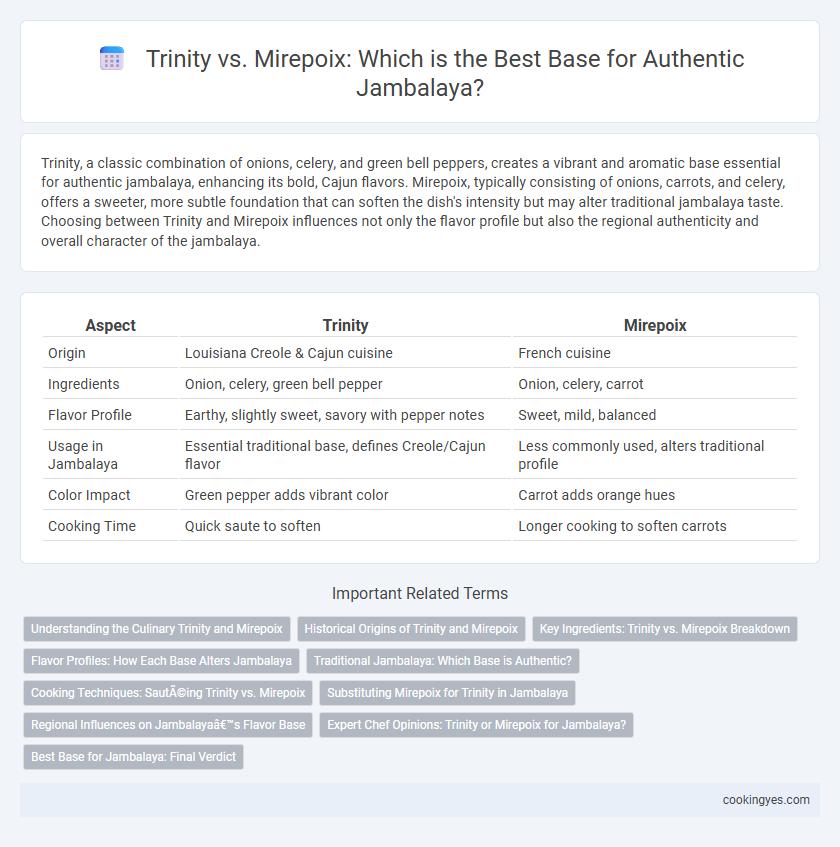Trinity, a classic combination of onions, celery, and green bell peppers, creates a vibrant and aromatic base essential for authentic jambalaya, enhancing its bold, Cajun flavors. Mirepoix, typically consisting of onions, carrots, and celery, offers a sweeter, more subtle foundation that can soften the dish's intensity but may alter traditional jambalaya taste. Choosing between Trinity and Mirepoix influences not only the flavor profile but also the regional authenticity and overall character of the jambalaya.
Table of Comparison
| Aspect | Trinity | Mirepoix |
|---|---|---|
| Origin | Louisiana Creole & Cajun cuisine | French cuisine |
| Ingredients | Onion, celery, green bell pepper | Onion, celery, carrot |
| Flavor Profile | Earthy, slightly sweet, savory with pepper notes | Sweet, mild, balanced |
| Usage in Jambalaya | Essential traditional base, defines Creole/Cajun flavor | Less commonly used, alters traditional profile |
| Color Impact | Green pepper adds vibrant color | Carrot adds orange hues |
| Cooking Time | Quick saute to soften | Longer cooking to soften carrots |
Understanding the Culinary Trinity and Mirepoix
The Culinary Trinity, consisting of onions, bell peppers, and celery, forms the foundational flavor base in Jambalaya, reflecting its Cajun and Creole roots. Mirepoix, a French classic made of onions, carrots, and celery, offers a sweeter, earthier profile but is less traditional for Jambalaya. Choosing the Trinity over Mirepoix preserves the authentic taste and vibrant complexity essential to this iconic Louisiana dish.
Historical Origins of Trinity and Mirepoix
The historical origins of the Cajun Trinity and the French Mirepoix reflect distinct cultural influences shaping Jambalaya's flavor base. Mirepoix, rooted in French cuisine, traditionally consists of onions, carrots, and celery, established in the 18th century as a foundational aromatic mix. The Cajun Trinity, emerging from Louisiana's Creole and Cajun heritage, substitutes bell peppers for carrots, emphasizing local ingredients and regional taste profiles essential to authentic Jambalaya.
Key Ingredients: Trinity vs. Mirepoix Breakdown
The key ingredients of the Cajun Trinity--onion, celery, and green bell pepper--provide a robust, earthy, and slightly sweet flavor unique to Jambalaya, enhancing its authentic Louisiana profile. In contrast, the French Mirepoix, composed of onion, celery, and carrot, offers a sweeter and milder base that alters the dish's traditional spice balance and depth. Choosing Trinity over Mirepoix preserves the regional spice and aroma essential for classic Jambalaya, while Mirepoix may soften the overall intensity and color of the dish.
Flavor Profiles: How Each Base Alters Jambalaya
The Cajun Trinity, consisting of bell peppers, onions, and celery, imparts a robust, earthy flavor that defines traditional jambalaya with its savory depth and slight sweetness. In contrast, the French Mirepoix, made from onions, carrots, and celery, introduces a subtly sweeter and more aromatic base, adding complexity and a lighter undertone to the dish. Choosing between Trinity and Mirepoix significantly influences jambalaya's flavor profile, with Trinity emphasizing bold, smoky notes typical of Cajun cuisine, while Mirepoix offers a nuanced, delicate balance that softens the overall taste.
Traditional Jambalaya: Which Base is Authentic?
Traditional jambalaya relies on the Holy Trinity--a combination of onions, celery, and green bell peppers--as its authentic flavor foundation, distinct from the French mirepoix that uses onions, carrots, and celery. The Holy Trinity provides a uniquely Creole and Cajun taste essential to Louisiana cuisine, aligning with the cultural roots of jambalaya. Using mirepoix shifts the flavor profile away from classic jambalaya, making the Holy Trinity indispensable for authenticity.
Cooking Techniques: Sautéing Trinity vs. Mirepoix
Sauteing the Cajun Trinity--onions, bell peppers, and celery--forms the authentic flavor foundation for Jambalaya, releasing bold, aromatic oils that complement the dish's robust spices. Mirepoix, a classic French blend of onions, carrots, and celery, provides a milder, sweeter base but lacks the distinct peppery kick essential to Cajun cuisine. Using the Trinity enhances Jambalaya's signature smoky depth through precise techniques like sweating the vegetables without browning, which intensifies the overall savory profile.
Substituting Mirepoix for Trinity in Jambalaya
Substituting mirepoix (onion, carrot, celery) for the traditional Cajun Trinity (onion, bell pepper, celery) in jambalaya alters the flavor profile by introducing sweetness from the carrots instead of the distinctive, slightly bitter taste of bell peppers. This variation results in a milder, less spicy base that shifts the dish away from its authentic Louisiana roots toward a more French-influenced flavor. Using mirepoix can also affect the overall color and aroma of jambalaya, giving it a different balance that may appeal to those preferring a subtler vegetable blend.
Regional Influences on Jambalaya’s Flavor Base
The choice between the Cajun Holy Trinity (onion, bell pepper, and celery) and the French Mirepoix (onion, carrot, and celery) significantly impacts Jambalaya's flavor profile, reflecting distinct regional influences. The Holy Trinity, originating in Louisiana, imparts a robust, savory base ideal for Creole and Cajun Jambalaya, while Mirepoix contributes a sweeter, more subtle aroma traditional to French-inspired cooking. This variation highlights the cultural fusion in Jambalaya recipes, showcasing how local ingredients and culinary heritage shape its signature taste.
Expert Chef Opinions: Trinity or Mirepoix for Jambalaya?
Expert chefs debate the ideal base for jambalaya, contrasting the Cajun Trinity--onion, celery, and bell pepper--with the French Mirepoix--onion, carrot, and celery. The Trinity is preferred for its authentic smoky, spicy undertone that defines Louisiana cooking, while Mirepoix offers a sweeter, more aromatic foundation typical in French cuisine. Chefs favor the Trinity for jambalaya's bold, robust flavors, emphasizing regional authenticity and depth over the gentler taste profile provided by Mirepoix.
Best Base for Jambalaya: Final Verdict
The best base for jambalaya is the Holy Trinity, a combination of onions, bell peppers, and celery, which provides the distinctive Creole flavor essential to the dish. Unlike the French mirepoix, which uses onions, carrots, and celery, the Holy Trinity enhances the spicy and savory profile unique to jambalaya. Chefs agree that the Holy Trinity is the definitive aromatic foundation that elevates jambalaya's authentic taste.
Trinity vs Mirepoix for Jambalaya base Infographic

 cookingyes.com
cookingyes.com